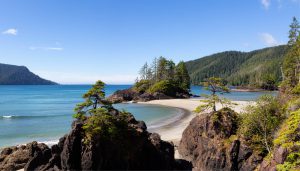As we descend further south along the Pacific coast, towards the Canadian westernmost province of British Columbia, a number of tree species are added to the Western American forest range. The vast majority are coniferous species, which benefit from the high humidity along the coastal areas and form real rainforests. Precipitation, also in the form of winter snow and summer fog, averages above 2000 mm to 4000 mm per year. This is where the first cypress-like species appear, many of which are characterized by their scaly green leaves and fibrous bark, which appears to be made out of long, peeling strips. The Western red cedar and the endemic Nootka cypress (found only here) are two examples. In addition to hemlock, the well-known Douglas fir appears here for the first time, immediately recognizable at a more mature age by its thick, rough, cork-like bark. Group 2 is bordered on the south side by a row of younger Grand firs, also known as Vancouver fir. Most of these tree species reach huge sizes in Vancouver Island and the surrounding areas after a few hundred years, several meters in thickness and heights over 60, 80, or even 100 meters among some of the Douglas firs. Whether these trees will ever reach those dimensions here in Tervuren, in less favorable conditions, is highly doubtful. Another feature of those forests that cannot be observed in Tervuren are the thick, damp mosses decked over the branches of such trees in their native forests.


